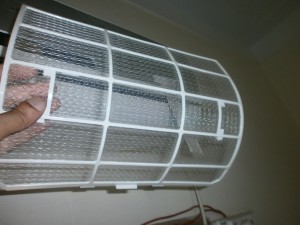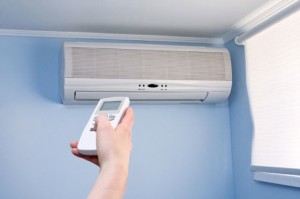How It Works
 Mini-Split systems use heat pump technology. Basically, heat pumps combine an evaporator and a condenser, using puron refrigerant and phase change to provide heating and cooling. They are essentially a high efficiency air conditioner that can also run in reverse to heat the home. The condenser is usually located outdoors. It distributes refrigerant through copper tubing, which is connected to one or more indoor outlets (evaporator + air handler).
Mini-Split systems use heat pump technology. Basically, heat pumps combine an evaporator and a condenser, using puron refrigerant and phase change to provide heating and cooling. They are essentially a high efficiency air conditioner that can also run in reverse to heat the home. The condenser is usually located outdoors. It distributes refrigerant through copper tubing, which is connected to one or more indoor outlets (evaporator + air handler).
Mini-splits are particularly efficient when compared to other HVAC systems, because they “recycle” energy, to some extent. Also, they use electricity instead of burning gas, which can be advantageous.
That being said, mini-split systems wont work for every home out there. They perform well assuming that the heating/cooling load (AKA heating/cooling needs or rate of heat loss/gain) is not too high. In other words, they should be used in conjunction with good sealing and insulation, and they are ideal for smaller homes and apartments, or homes where only certain rooms need heating/cooling.
This also works the other way around. When a particular room or smaller home is very tight and insulated, any MSHP (mini-split heat pump) you install in that room will likely be much more than that room actually needs. They only make them in so many incremental sizes. With a well designed forced air system you can direct just the right amounts of energy at a room. With a mini split system you just need to choose the one that fits the best. This being said, they are starting to come out with well made self-modulating mini splits that can adjust according to the needs of the room. Although any modulating unit (gas furnace or heat pump etc) does not work well with a ducted system, they can with a wall or ceiling mounted ductless mini split unit.
 Pros
Pros
1. Highly efficiency in the right application.
2. No gas required.
3. No ducts required! Mini-split systems distribute heat by blowing it into a room straight from the miniature heat pump coils located on any rooms’ upper wall or ceiling. No ducts mean less loss, no duct leakage, no future maintenance associated with duct work, and less variables for the average HVAC contractor to get wrong.
4. Despite the above #3, mini-splits can use a forced air system instead, using a central air handler and a duct system. If designed right, they can be used to efficiently heat/cool very low load homes.
5. Ease of Install: Mini-split systems are much easier to install than a well designed and installed forced air HVAC system. Since they are not limited by the existing duct system (which is often poorly engineered and provides uneven heating/cooling), they can be directed to the rooms/zones that really need it.
6. If your whole home is heated by electric heat pumps, you can call PG&E and have them switch you over to a cheaper rate plan associated with electric home heating. This offers more breathing room at your baseline usage level before it switches you over to a higher tier rate. This also works for a ducted heat pump system.
7. Any form of efficient electric heat further justifies the install of a solar PV system on your roof. You don’t need to pay PG&E anything other than the minimal average costs associated with gas cooking, gas dryer or a stove/oven.
 Cons
Cons
1. A single MSHP generally wont be able to handle a large, poorly sealed/insulated home in a hot/cold climate. Bear in mind, even though a powerful HVAC system can handle this situation, it’s going to use a ton of energy. Regardless of the heating/cooling technology, you simply cannot design a system well enough to compensate for a lack of insulation and sealing. Both a heating/cooling system design and improvements to the retention of the home need to be done in conjunction with each other.
2. Electricity is a bit more expensive than gas (at least in PG&E territory), which can slightly offset the efficiency gain on your utility bill. This depends on what tiered rate you are paying PG&E.
3. Although mini-splits are often advertised as being able to split 8 times, there is a huge efficiency loss when you run that many refrigerant lines, over that much distance. 1-3 splits is a more realistic, efficient and manageable option.
4. Cannot be fine-tuned as well as expertly engineered duct systems. However, well designed forced air duct systems are very rare, and it’s much easier to install a MSHP than to completely overhaul your ducts.
5. Any home larger than around 1000 square feet will benefit more from having a well designed forced air system. There are just too many rooms that are too spread apart to justify numerous mini splits indoor cassettes. Always be on the lookout for that one garage renovation or upstairs room that is hard to run a duct to. These situations are where mini splits shine the most.
 Case Studies
Case Studies
Due to the blooming success of heat pump systems, several recent case studies have been performed. They have shown varied but overall success using MSHPs, even in larger houses in relatively hot/cold climates. In one example, two MSHPs were installed in a two-story house, one for each floor. During winter, the 1st floor MSHP was doing the majority of the work, due to thermal buoyancy (heat rising), and during summer, the 2nd floor MSHP did most of the cooling. In both cases, the MSHPs performed well, and never reached maximum load, although they were in almost constant use during summer and winter.
One nice thing they discovered is that oversized MSHPs are usually not a problem, assuming they modulate their own capacity properly, and their target zones are large enough to provide the correct return for the temperature sensors. In fact, it turns out that oversizing can actually be beneficial, since they reach optimal efficiency when running at low capacity. This is not the case for traditional HVAC systems, which, when oversized, are inefficient and uncomfortable.
So, this is an example of how mini-splits can be used cleverly and efficiently. However, it should be stated that purchasing two MSHPs for a home isn’t cheap. Also, efficiency is highly dependent on proper installation and programming, and other aspects of the home’s performance. Occupant operation also has a significant impact.
Conclusion
Mini-split systems are great when you want to heat/cool a few select rooms, or a small, well insulated home, and you don’t want to have duct work done. They are especially great if you don’t have the space to install ducts in the building or in a room, or if you want to condition a room or two that can’t fit properly sized ducts. In these situations, they are relatively convenient to install, and highly efficient.
That being said, we always recommend air sealing and insulation as a first priority for any home, regardless of the type of heating/cooling system. Optimal efficiency will not be achieved without taking these steps first. For example, if you’re going to install a new furnace/AC, it should be done at the same time as other upgrades, to ensure proper sizing and distribution.

I like that split systems don’t require any gas or ducts. I am considering replacing my swamp cooler with some kind of air conditioning system in the next few months. A split system may be a good option for me, as it can function as both a cooling and heating system. This would be especially convenient during the spring and fall when it is warm in the day and cold at night.